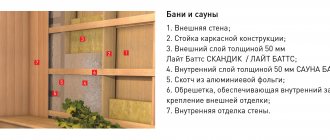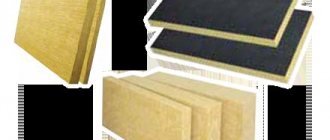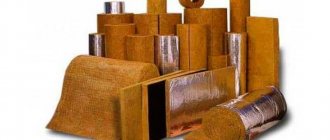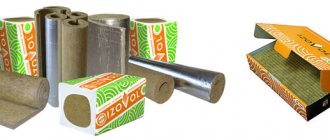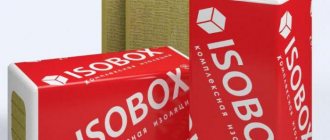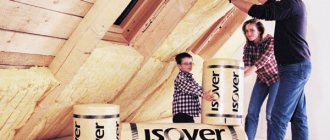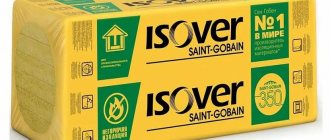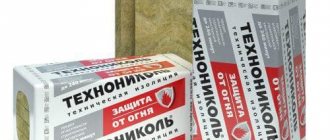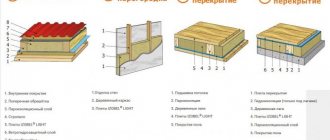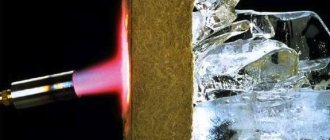Basalt wool is designed primarily to serve as insulation and retain heat in our homes in winter and keep cool in summer. The remarkable properties of the material allow it to be used on a large industrial scale, as well as in civil engineering. Basalt wool is widely used when carrying out work on thermal insulation of objects, and in addition serves as an excellent soundproofing tool.
Modern designers, when creating a new project, are very wary of new advertised building materials. This is due to past mistakes, when the construction complex sought to produce square meters in accordance with the tasks of the planned economy, without caring at all about the materials used, and without thinking about their impact on humans.
Recently, doctors have been sounding the alarm, expressing the opinion that the use of low-quality materials in the housing complex leads to asthma or, even worse, causes cancer problems. Particularly sensitive is the issue of using various heat-insulating materials; as a rule, they are covered with building structures and can affect us completely unnoticed.
Should we be concerned about phenol formaldehyde?
Mineral wool is safe for health.
The main arguments in favor of the fact that mineral wool is harmful to health are based on the presence of phenol-formaldehyde in it. It is part of the binder. In its pure form it is a poison and very strong, but is it really that dangerous in the composition of mineral wool, which allegedly stinks of formaldehyde?
If the manufacturer follows all the rules for the production of mineral wool, no harmful substances are released, except perhaps a small (minuscule) part, which will not affect health in any way. In this regard, the harm of mineral wool is too exaggerated. In addition, there have long been materials where the binder is made on the basis of acrylic. For example, Knauf insulation, made using the latest ECOSE technology, or the Ursa PureOne line of mineral wool. This is an absolutely safe insulation for the home.
The danger of phenol-formaldehyde in mineral wool is far-fetched.
This synthetic resin is part of many items without which our life is simply impossible:
- sockets, switches, plugs for electrical appliances, electricity meters;
- mobile phone, camera, computer housing;
- handles of knives, pots, pans, etc.
Not to mention adhesives, varnishes, impregnating compounds for plywood and wood boards. In other words, formaldehyde is everywhere, so why is so much attention focused on the dangers of mineral wool? You need to solve the issue either comprehensively, or not bother yourself with trifles.
You can make induction heating yourself only with a factory-made boiler. This is a complex unit that cannot be made at home.
Read all about electric heating elements for home heating here.
Environmental Safety
The main material of this insulation – basalt – is a natural stone.
Even when exposed to heat, it does not emit harmful volatile substances.
This cannot be said about materials from the foam group: when heated, even slightly, polymers emit gaseous substances that are harmful to health.
Therefore, for thermal insulation of hot surfaces, for example, heating equipment or a hot water tank, only basalt insulation should be used. The same can be said about the thermal insulation of the roof: in the summer it heats up to +60 degrees - this is quite enough for the thermal decomposition of polymers.
As for phenol-formaldehyde resin, which plays the role of a binder, it does not pose a danger in high-quality and certified insulation materials, since it is neutralized at the production stage.
For those who want to get an absolutely flawless material from an environmental point of view, some manufacturers offer brands of basalt wool in which phenol-formaldehyde resins are not used.
Irritation of the epidermis by mineral wool
The objective health hazard of mineral wool is irritation of the epidermis during installation. Indeed, there are prickly insulation materials among glass wool or basalt wool. But again, there are materials that can be used to cover yourself and there will not even be a hint of tingling or scratching of the skin.
Glass wool is harmful to skin health only if sufficiently large fibers of glass are used in its manufacture. Slag wool, which is made from waste from the metallurgical industry, is very itchy; it is not used for insulating houses, since it is really not a safe insulation for walls. Stone wool can also chip when, during installation, small pieces of fiber break off and land on the skin. To prevent contact of mineral wool with skin, it is enough to wear gloves and long-sleeved work clothes.
Considering the question of whether infrared heating is harmful to health, we came to the conclusion that it is even beneficial.
More details about infrared heating (characteristics and reviews) here.
Basalt wool application
German designers from EDAG have developed a concept car
, basalt fiber was used in the production of the body. According to experts, the material turned out to be light, durable and environmentally friendly, and most importantly, it is cheaper than aluminum and even carbon-plastic.
Mineral wool, which is based on basalt threads, acquires truly irreplaceable qualities: the wool is porous, temperature-resistant, excellent vapor permeability and neutral to chemical environments.
Properties
- basalt wool has a porous composition, the pores reach 70% by volume, often even more. When the pores are filled with air, wool is characterized by low thermal conductivity.
- temperature resistance is considered almost the most basic indicator of heat-insulating materials; this is of great importance in the thermal insulation of equipment used in industry. Operation of which often occurs during elevated temperature conditions. Temperature resistance is determined by the temperature at which the material is exposed, without changing its technical parameters.
- Vapor permeability - there is a good microclimate in the home and it is easy to breathe when the material allows water vapor molecules to pass through the pores. As we mentioned, basalt wool is a tangle of interconnected pores. They do not trap air or steam. Vapor permeability allows the cotton wool to always remain dry.
- basalt wool is neutral to oils, solvents and other organic compounds. Alkalis and acids also do not have a destructive effect, which indicates the high chemical resistance of cotton wool.
Thanks to its remarkable properties, the scope of application of basalt wool is constantly expanding and is finding wider application each time:
- heat and sound insulation;
- basalt wool for the chimney;
- fire protection in civil and industrial facilities;
- for a bath, for a sauna, for a change house;
- thermal insulation of power machines, pipelines;
- as a means of insulation in public catering: gas, electric stoves, frying ovens;
- insulation during the reconstruction of buildings, in work with flat roofs;
- insulation of high and low temperature mechanisms;
- interlayers for household and industrial refrigerators;
- in multilayer sandwich panels during the construction of light buildings
Harm of mineral wool to the respiratory tract
You need to wear a respirator and cover exposed skin.
Dust poses a major health hazard. There are types of mineral wool that are very dusty, especially basalt wool, since its fibers are inelastic. A safer insulation for floors, walls and roofs is glass wool, since it consists of long and soft fibers that do not break, and therefore there is no dust from it. Therefore, it is not dangerous in any way; glass wool is one of the best materials in terms of environmental friendliness and safety.
Why is dust getting into your lungs so dangerous?
- dust is not removed;
- blood oxygen saturation deteriorates;
- the physical potential of the body decreases;
- asthma may develop.
Dust appears both during installation and during further operation. You need to work in a respirator - this is mandatory, and a vapor barrier will help prevent dust from entering the room after installation. It is always used when insulating walls, floors, ceilings and roofs (attics included). The film creates a vapor-impenetrable barrier; naturally, hundreds of times larger dust particles will not be able to get inside the room.
What does insulation consist of?
Currently, the production of stone wool has reached a large scale. Many companies produce it, offering it at different prices. The product itself may also differ, which is influenced by the amount of resin used. stone wool is available for sale at a price of 400 rubles.
You can also find hard mats in stores, the price of which can reach up to 1,500 rubles. Moreover, this is not the limit for her. The raw materials for basalt wool are rocks. This is precisely what determines its advantage, such as non-flammability. But to bind its fibers together, a resin is used, which can easily catch fire. This component contains formaldehyde and phenols , which are damaged by drafts, precipitation and temperature fluctuations, which negatively affects human health. At the same time, the fiber also causes certain harm: when exposed to the above factors, it turns into fine and sharp dust, creating difficulties for breathing.
What is the safest insulation
Ursa PureOne - formaldehyde-free, acrylic based.
There is no point in determining which insulation is safe for health among natural materials, so only modern insulation of artificial origin should be considered. The most used thermal insulation materials:
- mineral wool;
- Styrofoam;
- polyurethane foam.
Formaldehyde resins
Many people want to know whether mineral wool, which contains formaldehyde resins, is harmful. The amount of resin in any basalt insulation is 2-3 %. This substance contains a very small amount of formaldehyde. Thus, mineral insulation contains a minimum amount of substances that affect health.
If you need to completely eliminate the harm of mineral wool, pay attention to manufacturers who do not use harmful substances in production.
Results
Mineral wool is a safe material, and its health hazards are greatly exaggerated. Of course, there are types that create a lot of dust during installation, but this can be solved by using a respirator. The dust is subsequently neutralized by a vapor barrier film. There are prickly materials that make your skin itch. But again, if safety precautions are followed during installation, this problem does not arise. And the fact that mineral wool contains phenol-formaldehyde does not mean that it somehow leaves the structure of the material. In addition, this component is present in all plastics, not to mention other materials.
Manufacturers such as Knauf and Ursa have a line of materials that use an acrylic-based substance as a binder. This insulation is definitely safe. If these arguments are not enough, then you can insulate with natural materials of natural origin, for example, sawdust, straw or expanded clay.
The first thing that can be said that basalt wool is harmful to health after reading many publications on the Internet is that the writers themselves completely misunderstand what is the difference between basalt wool and ordinary mineral wool and even glass wool, not to mention slag wool. For them, basalt wool is the entire construction market: ROCKWOOL, PAROC, Izovol, TechnoNIKOL, etc. In fact, all of the above is ordinary mineral wool obtained by centrifugation, but not basalt. The manufacturers themselves write that this is mineral wool. To produce mineral wool, when preparing the charge before loading it into the melting furnace, the basis is made up of basalt group minerals, but limestone or dolomite must be added, otherwise fibers will not be obtained. Mineral fibers obtained by centrifugation are very small, 1-3 microns in diameter and short. You cannot see elementary mineral fiber without a microscope. It will probably be a discovery for the “writers” that the mineral, glass or slag fibers themselves, which they call basalt, would be safe if they were not coated with phenol-formaldehyde resin to form thermal insulation boards. It is phenol that is a carcinogen and the causative agent of many dangerous diseases, primarily cancer. And the amount of phenolic dust in such a slab is up to 3÷4% of the total mass of the insulation. Calculate for yourself how much phenolic dust is in the walls and roof, if an average house uses about 80 m 3 of insulation with an average density of 60 kg/m 3, i.e. about 6 tons of mineral wool and phenol-formaldehyde resin will contain about 150 kg.
Therefore, by formulating the headline: “basalt wool is harmful to health,” the authors of the site’s articles pursue the goal: to divert the consumer’s attention from the harmful components of mineral insulation, because of which mineral wool insulation cannot be called environmentally friendly, focusing on small fibers that can actually get into the human lungs , like all the dust from the streets of big cities. And another question is which is more harmful: fine fibrous dust of mineral insulation with phenol, or dust from highways. Both are harmful. Yes, such mineral basalt wool is harmful to health.
Therefore, in all technical conditions for the installation of glass wool, mineral wool, slag wool and basalt wool, it will be written that when installing insulation it is necessary to work with the use of respirators, gloves, and tightly buttoned overalls. It is no secret that the most sick among construction workers are installers of mineral insulation.
And this is what happens when you see the headline: “Basalt wool is harmful to health , what we mean is basalt-based mineral wool using phenol-formaldehyde resin.
But where did the name basalt wool come from, if almost all the insulation is made of mineral wool?
Why do sellers of mineral wool, glass wool and slag wool call their product basalt insulation?
Basalt wool phenol formaldehyde
Phenol production in the world amounts to more than 10 million tons/year. Phenol is considered one of the strongest industrial pollutants. Phenol is a toxic substance dangerous to animals and humans. Phenol is very difficult to undergo even biological purification. With all this, it serves as an indispensable component in the production of phenol-formaldehyde and epoxy resins, widely used in construction and everyday life.
It is phenol, being exposed to the destructive effects of drafts, precipitation moisture and temperature changes, that negatively affects the physical condition of a person. Of course, the fibrous structure also makes its contribution: when exposed to certain factors, cotton wool contributes to the formation of fine and sharp dust, which in turn negatively affects our lungs and mucous organs during breathing.
Insulation materials: “white list” (environmentally friendly materials)
- Important
- Registration: Apr 2008
- Posts: 540
Answer: METTEMPLAST (Penoizol) - what kind of miracle is this?
I'll be happy to start.
1. Burnt clay in all its forms (both balls and bricks) is a (rare) problem, a slightly increased yield of gamma quanta, you can forget it;
2. Concrete with mineral (cement or lime or some other) binder and without organic fillers. These include cellular and silicate (in the form of the same brick) and light ones. For some varieties it is also worth checking the radiation.
3. Peat and products made from it. Limit the dusting of the overdried by creating between peat and placing screens, for example, made of paper (the same wallpaper - already a screen).
4. Fluffy antiseptic cellulose (aka Ecowool). composition: cellulose, borates (boric acid salts). Borates are not volatile; they were used to poison cockroaches in the 70s. If you don’t eat this salted cellulose and, as with peat, limit dust, it’s a very good ml.
5. Well, straw, manure, clay with sawdust, etc. – these are handicrafts and should be put in the “very local materials” section, I can’t talk about that seriously.
6. Of the synthetic polymers, I would recommend polyethylene foam. And not even because its breakdown products are not harmful, but because the decay rate is extremely low. Durable, infectious, just need to be hidden from the sun, otherwise it will quickly become brittle and crumble.
7. Oh, I forgot the tree. Solid wood (although it depends on what they use to prevent it from frying).
8. As for mineral wool, I would say this: low-density basalt fiber is tolerable. There is little astringent organic matter, and cotton wool fibers, once in the lungs, will calmly dissolve there - cotton wool melts with a bang in acidic water.
And glass fiber is acid resistant. Therefore, if there is a leak in the roofing pie, it will live longer, but once it enters the body it will never leave it.
9. I forgot the foam glass. There's nothing to complain about there unless you chew on it.
10. What else? Cork is exotic. Hemp, broken into fibers, but not tied into hemp ropes - romantic, of course, but also exotic.
Common myths about stone wool
The following myths about the dangers of stone wool are very common among people:
Common myths about the dangers of basalt wool
Myth 1: Releases harmful substances into the atmosphere
As I said above, the production of this insulation is carried out using resins. Therefore, many people are sure that the material releases formaldehyde into the environment, which is harmful to health.
There are harmful substances in the composition - a binder, i.e. resin, includes formaldehyde and phenol. These substances can indeed be significantly harmful to health.
Mineral wool can be used for internal insulation of housing due to its minimal content of harmful substances or their complete absence
However, the resin is in a processed form, in addition, its amount in stone wool does not exceed 2-3 percent. Those. the formaldehyde content is so low that it is not released into the atmosphere. Therefore, insulation materials based on basalt wool comply with GOST R 52908-2008 (EN 13820-2003).
Some mineral wool manufacturers refuse to use chemical resins altogether. As a result, the material is completely environmentally friendly.
Stone wool causes virtually no skin irritation
Myth 2: Causes severe skin irritation and serious illness
You can often hear that basalt wool is harmful to health due to sharp and fragile fibers, which, if they come into contact with the skin, cause irritation and allergies. In reality, this statement is also not true.
This myth is due to the fact that stone wool is judged by the well-known glass wool, or these two materials are simply confused. Glass wool does cause skin irritation and can also cause serious respiratory problems.
The damage from basalt fiber is significantly less than from glass, since the fibers are not as fragile. From my personal experience I will say that even when working with mineral wool in the summer, no particular discomfort arises.
You need to wear gloves when working with mineral wool
When basalt wool gets on the skin, it can cause a tingling sensation, but once you shake it off, it goes away. Of course, you need to wear gloves when working with it yourself.
True, all of the above applies only to basalt insulation. The fibers of slag wool are almost as brittle as those of glass wool. But, as I said above, recently slag wool has practically not been used for home insulation.
The elastic basalt fibers that make up the slabs generate virtually no dust.
Myth 3: the material is very dusty
Many people believe that basalt wool is harmful to health due to its strong dusting. Dust can harm the respiratory system.
Of course, if basalt wool gets into a person’s lungs, there is little good in it. But the misconception about heavy dusting, like the previous myth, is associated with the characteristics of glass wool. In reality, the material cannot cause harm for the following reasons:
- The fibers are elastic. Due to the elasticity of basalt fiber, there is much less dust from it. The insulation itself does not generate dust at all;
- Large dust is generated. During the cutting process, the dust generated is quite large, and as a result does not pose a threat to health;
- Use of waterproofing. The installation instructions for this thermal insulation material require the use of vapor barrier. Those. it is covered with a film and, accordingly, cannot cause any harm to health, even if it were dusty.
Insulating wooden walls with mineral wool will preserve the natural microclimate in your home
At the same time, due to the fibrous structure, stone wool insulation has high vapor permeability. This allows you to maintain the natural microclimate in your home if the walls, for example, are made of wood or other vapor-permeable materials.
A comment
- Registration: Sep 2009
- Posts: 75
Answer: METTEMPLAST (Penoizol) - what kind of miracle is this?
I'll be happy to start.
6. Of the synthetic polymers, I would recommend polyethylene foam. And not even because its breakdown products are not harmful, but because the decay rate is extremely low. Durable, infectious, just need to be hidden from the sun, otherwise it will quickly become brittle and crumble.
Regarding polyethylene, I will add that it becomes embrittled in the sun due to the evaporation of the plasticizer. And so there can be quite a lot of additives in polyethylene, for example: p - pigment or dye, s - stabilizer, t - sliding additive, a - antistatic additive, f - modifying additive. And unlike polyethylene, their environmental friendliness is questionable. And their volatility is obvious, we smell it when we open a polyethylene canister, and we see it when the polyethylene crumbles, having lost the plasticizer.
With polymers, things are not so simple.
Harmfulness
Despite its natural origin, basalt wool can be harmful to human health.
Particular care should be taken when using cheap insulation. It may well turn out that a far from perfect technology was used for its manufacture, as a result of which the material emits abundant phenol and formaldehyde fumes.
Another danger, characteristic not only of cheap varieties, but also of expensive ones, is associated with high dust formation.
Miniature needles irritate the skin, causing itching. If they enter the respiratory tract or eyes, they pose a particular danger.
In this regard, the installation of basalt wool must be carried out wearing a respirator, gloves and safety glasses. It is better to throw away the overalls after delivery or installation of insulation: they are literally saturated with a large amount of dust.
Thermal insulation material must be non-flammable, not afraid of contact with water, and also be environmentally friendly. How to insulate the roof of a private house and what materials best meet all the requirements, you will learn in the article.
We will consider options for flooring in the kitchen in the next article.
A comment
- Registration: Sep 2009
- Posts: 75
Answer: METTEMPLAST (Penoizol) - what kind of miracle is this?
As for ozone, I would not be mistaken; we do not live in the stratosphere, and the amount of ozone in the ground layer is negligible. As for UV, of course there is such a thing, it destroys it little by little. But considering that the connections are saturated and there are few branches, it is quite weak. Why do plastic pots that have been sitting in a warehouse for 10 years crumble? There is no trace of UV or ozone. Alas, polyethylene is a partially crystalline polymer, and over time the degree of crystallinity increases, and with it fragility, and so that it does not crumble ahead of time, plasticizers are added. And smell the new PE canister inside, neither polyethylene nor ethane itself smell, so what does the new canister smell like?
Harm to health of mineral wool microparticles
It is believed that maximum harm to the body is caused by inhaling mineral insulation fibers. It's true: getting microparticles of basalt and resin into your lungs will not bring anything good. When cutting mineral insulation during construction work, fine dust is released, so you should work in a gauze bandage.
But once the insulation is already in place, it does not produce dust on its own. In addition, in most cases, the material is covered with a film to increase thermal insulation properties and waterproofing. This ensures the safety of the mineral wool.
There is mineral insulation of the latest generation, which does not chip and creates almost no dust. The reason lies in the elasticity of the acrylic contained in its composition: the fibers associated with this material do not break off and do not fly apart in the form of microparticles. This is not the only advantage of the material; it has improved soundproofing characteristics also thanks to acrylic, which absorbs sound waves more effectively. Thus, it is possible to completely avoid the appearance of dust when using mineral insulation.
A comment
- Registration: Jan 2010
- Posts: 5
Answer: Insulation materials: “white list” (environmentally friendly materials)
Well, if you bring an example with shoes (I wrote on the next branch). The best shoes for Siberia are felt boots! But, we should at least get a little wet. THOSE. go into a warm room with snow on your felt boots, and you’ll freeze very quickly. All cellular concretes have high moisture accumulation. And God forbid, even relying on thermal physics, they will make the thickness minimal and seal it tightly with brick! All. Turn off the lights and drain the oil. The facts have already accumulated - through the roof! AERATED CONCRETE, FOAM CONCRETE. Frozen walls. Black corners. The walls inside the house are icy. Which is not and cannot be in houses made of brick, even 75 cm thick. Verified. Materials for Siberia must be homogeneous. Moisture consumption is no more than 6%. And frost resistance is at least 75. Do you want less wall thickness? Think! Just really think, and don’t fall for advertising appeals!
Structure and technical features of the material
Basalt is a type of rock, in other words, stone.
It often reaches the surface of the earth in a molten state, pouring out from the craters of volcanoes in the form of magma.
In one of these places, basalt fibers were first found, attracting attention with their surprisingly high strength.
The randomly discovered fiber began to be produced artificially:
- Basalt is heated to one and a half thousand degrees.
- The resulting melt is loaded into a special drum with blowing. Streams of molten stone quickly solidify, turning into fibers with a diameter of about 7 microns and a length of about 5 cm. To assemble them into longer structures, a binder is used - phenol-formaldehyde resin.
- Next, a portion of basalt fibers is pressed, resulting in the final product - stone wool.
In its “device” it is completely identical to ordinary cotton wool: between numerous thin fibers there are equally numerous air layers, which provide high thermal resistance.
Basalt wool has “relatives”: glass wool, the fibers of which are obtained from molten glass, and slag wool, the raw material for which is blast furnace slag. For these and similar materials, the general name “mineral wool” is used.
Among all the representatives of this family, basalt insulation is definitely the best: it is the most moisture-resistant (all mineral wool materials absorb water, turning from heat insulators into “thermal conductors”), more environmentally friendly compared to slag wool, and does not hurt your hands like glass wool.
A comment
- Registration: Jan 2009
- Posts: 875
Answer: Insulation materials: “white list” (environmentally friendly materials)
If you want to see frozen black corners and slopes in a brick house, come to Sheregesh, I saw enough of this stuff there, damp, cold, brrr. The whole village is built of red clay bricks 2.5 thick, 5 floors, and everywhere everyone has the same problem
PS I go there several times every winter, staying in apartments, always different.
Choosing basalt insulation according to its main characteristics
When choosing a material, in addition to environmental friendliness, such characteristics as thermal conductivity, vapor permeability, water absorption and density are taken into account:
- thermal conductivity. The chaotic arrangement of fibers in basalt insulation contributes to the formation of air layers, which are an excellent heat insulator. For this reason, this material has a very low thermal conductivity coefficient: from 0.032 to 0.049 W/mK. The lower this indicator, the smaller the basalt insulation layer can be;
- vapor permeability. The moisture contained in the air, penetrating through the basalt insulation, does not form condensation inside. The vapor permeability coefficient ranges from 0.3 to 0.37 mg/m.h.Pa depending on the density of the material (the higher it is, the lower the coefficient);
- water absorption. It is measured as a percentage of the amount of water absorbed by the dry material to its original mass. Therefore, when choosing basalt insulation, choose the one with a lower percentage of water absorption;
- density. Varies in the range from 35 to 200 kg/m3. For frame structures, a material with a density of 35 to 75 kg/m3 is used, and basalt insulation with a density of 150 and higher is used as the main thermal insulation layer in reinforced concrete coatings.
As for indicators such as durability and fire resistance, they are the same for all basalt insulation materials: service life is 50 years, and the flammability group is NG (non-flammable). The material can withstand temperatures up to 1000°C, and does not melt.
Manufacturers of environmentally friendly basalt insulation
Most manufacturers of basalt insulation use synthetic resins based on phenol and formaldehyde as a binder, even though the word “eco” may appear in the product name. In fact, the list of enterprises producing environmentally friendly and harmless insulation based on basalt rocks is still small.
The company specializes in the production of environmentally friendly basalt insulation. Manufacturer's slogan: 100% basalt insulation without phenol - warmth and comfort for your home! PVA dispersion or bentonite clay with a water repellent is used as a binder.
Mineral wool: how dangerous is this insulation to health?
According to a number of experts, one of the most harmful building materials is mineral wool. Mineral wool is used for heat and sound insulation of residential premises everywhere. Some experts believe that the components included in its composition - mineral fibers, resins that bind them, which reduce the moisture absorption of the impregnation - cause serious diseases of the respiratory tract, eyes, and skin in people. The Association of Russian Thermal Insulation Manufacturers insists on the safety of its products. Builders, however, continue to use this thermal insulation material, which causes so much controversy. And officials don’t even try to figure out whether residents of mineral wool houses are endangering their health.
Today, the main share of the domestic market of thermal insulation materials is occupied by mineral wool producers. Mineral wool, especially slabs and sandwich panels based on it, are quite popular insulation in Russia. Where to buy mineral wool? Anywhere. Mineral wool is sold on any construction market, including on specialized websites on the Internet. Mineral wool is used for insulating pipes, utility rooms or houses from almost all sides: for insulating the walls of a house (outside and inside), facades, ceilings, attics, attics, loggias, as well as for sound insulation and noise insulation.
At the moment, you can buy mineral wool from various manufacturers on the Russian market. There are many of them, including Russian and Ukrainian factories; mineral wool production is established in Zheleznodorozhny, Kstovo, Kharkov and other cities. There are different types of mineral wool: foil, that is, with foil, acoustic mineral wool, in addition, various products made from it - pierced mats, thermal insulation cords, sandwich panels, slabs, cylinders, it is also sold in rolls (rolled), etc. Mineral wool is produced in different sizes and densities.
However, many foreign and Russian construction companies refuse to insulate their facilities with mineral wool. Firstly, due to the widespread and cheaper prices of competing insulation materials (silicate fiber, expanded polystyrene foam, polyurethane foam, polyethylene foam, etc., as well as insulation based on plant raw materials), and secondly, because of the harm, in their opinion damage caused by mineral wool to the environment and human health.
Is mineral wool the scent of death?
People began to argue and write about the dangers to human health and the environment from mineral wool relatively recently. Previously, it was believed that mineral wool as insulation was completely safe, environmentally friendly and non-flammable. And these qualities compensated for the fact that the price of mineral wool is higher than that of some other thermal insulation materials. But now a number of ecologists, doctors, and builders have begun to argue that the safety of mineral wool is, to put it mildly, exaggerated. In their opinion, the fibers contain carcinogenic components, and the binding material is phenol-formaldehyde or melamine-formaldehyde resin, which releases free formaldehyde, as well as phenol - highly toxic substances, in fact, are poisons for the human body.
